*ADDENDUM*
I attempted to make a typewriter pad out of 4 mouse pads, as I happen to have lots of these Secret Society Wars mousepads hanging around. Result: utter failure. Witness the hard shift to the left after just 3 lines of typing. The mouse pads didn’t move, but it appears the top surface isn’t grippy enough:
*UPDATED UPDATE*
I found a slice of package padding foam among the materials I’ve been using to pack with, and cut a square out the right size for a typewriter pad. Result: SUCCESS! This stuff is somewhere between foam rubber and styrofoam in hardness, and is slightly grippy on both sides. The sheet I used is about 3/4″ thick. with this stuff underneath it, the machine won’t budge and is much quieter, although slightly springy when typing:
*EVEN MORE UPDATED UPDATE*
After some distracted googling around it seems that the last online source for typewriter pads is MyTypewriter.com, where they are sold for $24.95 and are advertised as “based on specifications of an original typewriter pad from the 1940s”. I have seen exactly *one* typewriter pad in my life, and that one is at MTE. I did try it out and found the feel of the typewriter is made substantially smoother and weightier. However the pad that Bill has at MTE is at least an inch thick and has a coarse layer on the top that grips the machine like very tightly wound berber carpet. The ones at MyTypewriter look anemic next to that, and are just a wool slab with no top grippy layer.
Vintage Typewriter Shop seems to be out of typewriter pads. Too bad, as theirs at $19.95 has a neoprene grippy layer attached to the felt. These might be similar to the ones that Richard Polt had made, and sound nice.
So, for the moment, I’m satisfied with the packing foam slab, although, I should note that heavy typewriters do sink a bit into the foam overnight, so an exposed-bottom machine might have issues, but these are solved just by flipping the foam sheet over. I suppose the next step is finding out a place where you would buy a sheet of this stuff, as I got mine out of a box that someone had shipped a typewriter to me in.
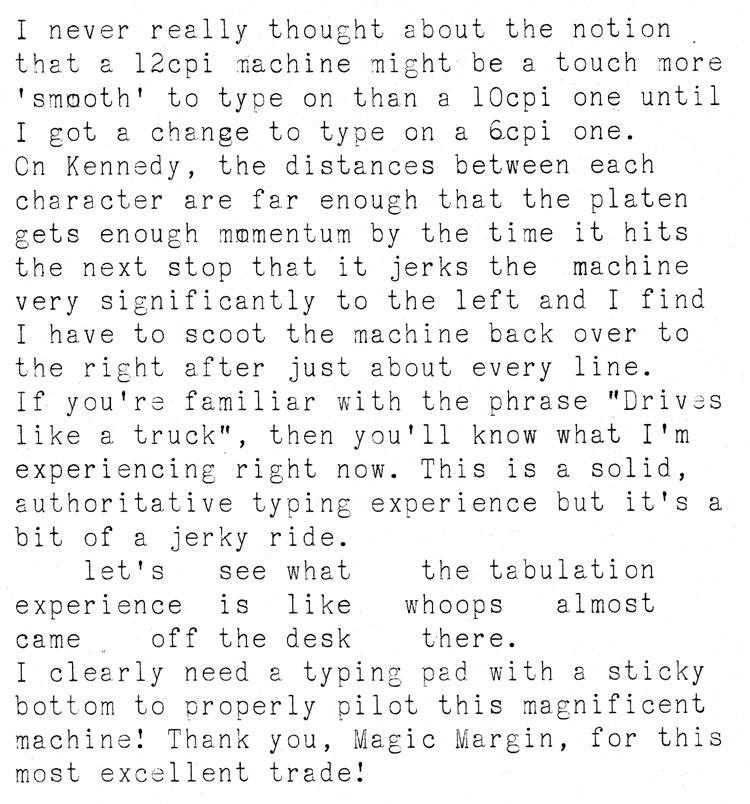

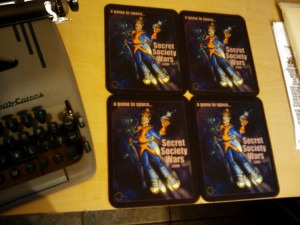
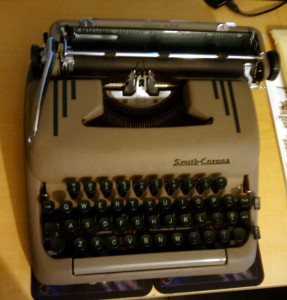
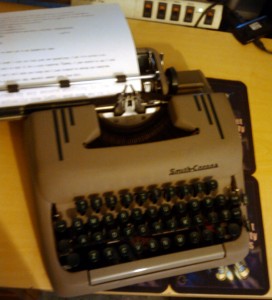

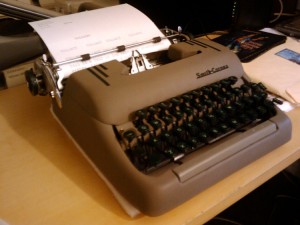
A couple of years ago I got a company to make a batch of typewriter pads. They’re half an inch thick, with a synthetic rubber backing (which is actually slightly too slippery). I had the batch shipped to me, and sold them at cost to interested typists. I believe price with shipping came out to only $11/pad. I believe it’s time to make a new batch. I’m very busy at the moment so I hope someone else will step up. I don’t think I have the information anymore on the company that made them; you’d need to some googling.
I like the COLLECT/preserve collaboration, by the way!
Nice typeface on this one. Mike Clemens was knitting typewriter pads for awhile! I just put up with the bouncing myself, too lazy to remedy the situation.
Guilty as charged. Find a knitter and supply him/her with a stock of interesting DVDs and a mug of something warm and satisfying, and they will turn out typing pads until the cows come home. Excursions were:
http://clickthing.blogspot.com/2008/10/diy-typing-pad.html (the plan and “pattern”, using the term loosely)
http://clickthing.blogspot.com/2008/10/it-all-comes-out-in-wash.html (the results)
Things I learned:
* A wool felt pad is nice and thick. So very thick, in fact, that heavier typewriters will want to sink into it, leaving the typebars pressed up against the wool. I’ve since encountered two “real” typing pads, and they are certainly denser than my own attempts, although all I really need to do is chuck mine back into a hot wash for a while. (I’ve made two so far.) Until that day comes, I’ve learned to put rubber furniture feet between my typewriter and the pad — those things you put your sofa legs into to keep them from marring your priceless antique oak floors. This gives the typer just enough extra height and keeps the underside from interfering with the pad, and vice versa.
* The sinking helps with the skidding, but underneath you still need something. The common recommendation is to get a roll of that rubber no-skid stuff you slip under rugs and cut a piece to size (our dollar store sells it, even.) This goes on any layer that isn’t grippy enough. It’s *vey* stable after that, but not permanent, and easy to pick up. Some folks just use a longer sheet of the stuff, folded over a few times.
The whole point of the pads are to absorb the vibrations from the machine, which keeps your kitchen table from thumping like the speakers in your local delinquents’ Saturday-night-cruisin’ car. The rubber sheeting is pretty effective at dampening transmitted vibrations, but I like my felt pads even more.
As far as I can see from your photos, I use the same packaging foam, although a bit thinner, and am happy with it.
Yep, it seems to work very well, and can be scrounged up for free. I recommend it. (:
Yes, thank you for the suggestion. I am looking around for a solution to a new typewriter that I bought, found your page, and see you have almost the same machine I have: a Smith-Corona manual green Enterprise from 1960/61. These carriages are too heavy for the lightweight body. It’s beautiful, but I need to make it practical. I’ll try to find your foam thingey.
I use a horse saddle pad. Works great.
Interesting. I have sheets of LDPE (Low Density Polyethylene) packing foam. It should be easy to find and you can get it various ‘weights’ and thickness. It’s a great solution for vibration reduction (but not the best for the environment – it’s recyclable into more of itself, but otherwise landfill).